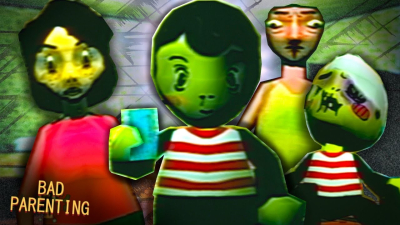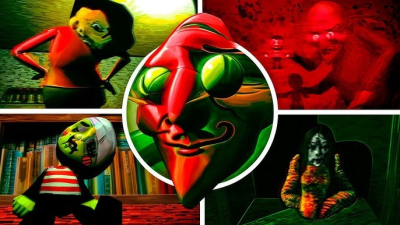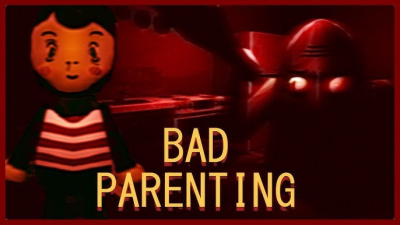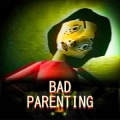Bad Parenting
I still remember the day I stumbled upon Bad Parenting 1: Mr. Red Face. I was browsing through an obscure corner of an indie games forum when the title caught my attention. Its quirky premise immediately piqued my curiosity. The notion of exploring the challenging and humorous world of mismanaged household dynamics was unlike anything I had ever seen. I decided to take a plunge into this offbeat realm and found myself immersed in a chaotic blend of comedy, strategy, and unexpected emotional depth. From my very first moments in the game, I knew I was in for an experience that would test my patience, creativity, and sense of humor simultaneously.
Exploring the Unconventional Gameplay Mechanics
Bad Parenting 1: Mr. Red Face offers a gameplay experience that defies conventional indie game formulas. Instead of focusing solely on a linear storyline, the game presents the player with various scenarios where making parenting decisions becomes an exercise in ingenuity under pressure. I appreciated how the mechanics encouraged me to think on my feet; each choice carried a ripple effect, altering the behavior of characters and shaping the unfolding narrative. Every time I played, I discovered new challenges, often humorous in their absurdity yet unexpectedly profound. The gameplay felt like a dance between humor and responsibility, drawing me further into its bizarre and unpredictable world.
In many instances, I had to balance time-sensitive decisions with long-term strategy, reminiscent of a puzzle with constantly shifting rules. The consequences of my actions were neither immediately obvious nor entirely predictable. This element of surprise kept me engaged, even in moments of apparent chaos. The game managed to create a sense of urgency without overwhelming me, maintaining a perfect equilibrium between challenge and delight.
A Narrative Steeped in Wit and Irony
One of the most captivating aspects of Mr. Red Face is how its narrative is woven with wit and irony. I found myself laughing at scenarios that oscillated between ludicrous mishaps and poignant reflections on familial bonds. The dialogues, laden with clever humor, often left me contemplating the peculiarities of modern parenting. Throughout the game, the script cleverly juxtaposed the seriousness of parental obligations with the absurdity of misunderstandings and miscommunications.
While Robbie, the uncanny protagonist, navigates the intricate maze of his daily responsibilities, the narrative never strays too far into cynicism. Instead, it portrays flawed and endearing characters who reflect the trials and tribulations of everyday life. I was struck by how the game managed to show flaws and vulnerabilities without losing its lighthearted tone, offering both amusement and a subtle commentary on the imperfections of human behavior.
Character Design, Animation, and Expressiveness
Every character in Bad Parenting 1: Mr. Red Face is brilliantly crafted with careful attention to design nuances. I found the titular character, Mr. Red Face, to be particularly memorable. His animated expressions and exaggerated gestures added layers to the narrative that words alone could not convey. The animations, though not overly polished by mainstream standards, exuded a raw, handmade charm that resonated with the overall aesthetic of the game.
Interaction with the characters felt lifelike in its absurdity. Their actions, reactions, and the diversity of their personalities made every scenario feel fresh and unpredictable. The slight exaggeration in facial expressions and body language provided a visual commentary that paralleled the satirical storyline. I often paused to appreciate the intricate details that the designers subtly embedded, each moment reinforcing the game's atmosphere of chaotic, yet heartfelt, mishandling of parenting duties.
Visual Style and Aesthetic Appeal
The graphical presentation in Bad Parenting 1: Mr. Red Face is a delightful fusion of cartoonish exaggeration and realistic detail. The color palette is vibrant without being jarring, capturing the essence of a playful world set against everyday trials. I was particularly enamored by the way backgrounds were rendered, often reflecting a juxtaposition between the mundane settings of suburban life and the surreal events that unfolded on-screen.
Every scene is crafted with a keen eye for thematic consistency, balancing the starkness of reality with the outlandish nature of the in-game events. The character animations, though minimalistic in some respects, are executed with a unique artistic flair that enhances the overall atmosphere. The creators managed to evoke both nostalgia and novelty through the aesthetics, cementing the game’s identity as an indie gem.
Soundtrack and Auditory Experiences
As I delved deeper into the game, I began to notice its thoughtful approach to audio design. The sound effects are humorous yet precise, capturing the essence of each action and scenario. Throughout my sessions, every quirky decision and unexpected mishap was punctuated by an array of audio cues that enhanced the immersive experience. The soundtrack, an eclectic mix of upbeat tunes and quirky melodies, perfectly complemented the game's offbeat narrative.
The background music is subtle enough not to overpower the conversations but dynamic in a way that reflects the shifting moods of the story. Sound effects play a significant role as well; every minor detail, from a creaking door to an exasperated sigh, ties the auditory world seamlessly with the visual storytelling. I found that the sound design provided a rhythmic backbone that pulsed in perfect harmony with the chaotic events of the game.
Innovative Interaction and Decision-Making Processes
The decision-making framework in Bad Parenting 1: Mr. Red Face stands out as both refreshingly innovative and deeply engaging. I experienced moments where choosing the correct course of action required a delicate balance of logic and intuition. Small, seemingly insignificant decisions could later unlock unexpected outcomes, establishing a chain of events that rang with both humor and gravity.
This interactive design strategy compelled me to rethink conventional game decision systems. I felt as though my choices mirrored real-life consequences, presenting me with a microcosm of the challenges and unpredictability inherent in daily responsibilities. Every interaction is laden with consequences that revealed the game’s subtle encouragement to ponder the complexities of life and family, beyond the superficial hilarity of the gameplay.
Responsive Controls and Fluid Game Dynamics
One of the key technical strengths of the game is found in its control system. As I began to master the interface, I quickly appreciated how responsive and intuitive the controls were. The developers took care to ensure that every command, from simple navigation to intricate action sequences, was fluid and precise, contributing to an overall sense of satisfaction during each play session.
The control scheme was designed with clarity in mind, making it easy for me to dive into the action without requiring an extensive learning period. Even in intense, fast-paced moments, the responsiveness of the key actions helped me execute decisions exactly when needed, amplifying the thrill of steering the narrative in unexpected directions. This ease of interaction played a significant role in keeping my enthusiasm alive throughout hours of gameplay.
Intricate Level Design and Structural Pacing
The layout of the game environment is another aspect that garnered my admiration. Each level in Bad Parenting 1: Mr. Red Face is meticulously designed to evoke both a sense of familiarity and an ever-looming potential for disorder. I enjoyed exploring the various settings, each constructed with care and ingenuity. The pacing of events within each level is carefully calibrated, ensuring that moments of calm are interwoven with bursts of action and surprising twists.
Some levels unfold like immersive mini-dramas, where the atmosphere shifts gradually, much like the real-life progression of a day filled with typical yet unpredictable chores and crises. This clever design allowed me to both anticipate and be surprised by future developments. I must say, the way each architectural element serves the dual purpose of storytelling and interactive gameplay management left a lasting impression on me.
Engagement Through Uneven Paths and Hidden Depths
The game continuously rewarded my curiosity with twists hidden beneath seemingly straightforward encounters. I found the narrative to be peppered with unexpected layers that made each re-engagement feel like a discovery of new, hilarious perspectives on an otherwise ordinary subject. Some parts of the game invited me to explore offbeat storylines that felt like secret chapters, deepening my understanding of the characters and their underlying motivations.
This structure of unearthed complexity encouraged me to replay various segments, each time uncovering fresh layers of nuance and humor. I realized that beyond the overtly humorous scenarios, there was an intricate web of decisions and consequences meant to mirror the unpredictable nature of everyday life. The blending of nonlinear storytelling with dynamic decision-making transformed every playthrough into a novel exploration of misadventure.
Humor as a Catalyst for Emotional Resonance
One of the aspects that resonated with me most profoundly was the game’s approach to humor. Rather than relying on crude or overtly simplistic comedic tropes, Mr. Red Face achieved its laugh-out-loud moments through a genuine, witty portrayal of dysfunctional yet loving family dynamics. I appreciated how the characters, in their flawed humanity, provided moments of both hilarity and introspection.
The game’s narrative is littered with quips, situational comedy, and tongue-in-cheek scenarios that forced me to confront the absurdity of everyday challenges. This humor, while lighthearted, also carried an emotional weight that connected to deeper themes of personal responsibility, regret, and hope. It made me laugh at the absurd situations but also allowed me to reflect on my own experiences, creating a bittersweet yet engaging narrative mélange.
Reflecting on My Personal Gameplay Journey
As I navigated through the unpredictable landscape of Bad Parenting 1, I began to realize just how much the game echoed the complexities of real-life familial interactions. I found that many of the decisions I made mirrored the unexpected consequences that often characterize everyday life. The experience was at once chaotic, profoundly funny, and occasionally introspective in a way that few games are capable of achieving.
The repeated challenges and convoluted decision points were not only entertaining but also provocative. I encountered moments where the choices pushed me to re-evaluate my personal approach to obligation and care. In one scenario, a seemingly insignificant decision regarding a household chore spiraled into a cascade of unforeseen events that showcased both the unpredictability and the intrinsic value of nurturing relationships.
This reflective journey through quirky mishaps and fraught encounters left me with a sense of accomplishment—I had managed to navigate the tangled web of choices in a game that did not dictate a clear end but rather celebrated the messy nature of life itself. There were moments where the humor offered not just laughter but an invitation for self-examination. Every session felt exactly like exploring a multi-layered narrative where the simple act of making decisions turned into an art form.
Observations on the Cultural Resonance of the Game
From a broader perspective, I couldn’t help but draw parallels between the game’s narrative and the cultural dialogue about responsible caregiving. Bad Parenting 1: Mr. Red Face taps into the zeitgeist of modern anxieties surrounding parenting and self-care, a topic that is often avoided in mainstream media. I was captivated by how the game managed to tackle sensitive topics with both levity and respect.
In a world where societal expectations often generate overwhelming pressure, the game provided a satirical yet empathetic commentary on the trials of everyday life. I found that, as much as I was laughing at the ludicrous scenarios, I was also confronted with a mirror reflecting my own experiences and insecurities. The balance achieved between humor and reality was impressive and served as a reminder that, at its core, the game was celebrating the resilience found in even the most chaotic circumstances.
An Ongoing Engagement with a Living, Unpredictable World
Every moment spent playing Bad Parenting 1: Mr. Red Face reaffirmed that the game is much more than a source of amusement—it is an evolving ecosystem of challenges and rewards. I noticed that the seamless interplay between storytelling, interactive mechanics, and visual artistry maintained my engagement well beyond the initial novelty. In each session, both small successes and quirky mishaps propelled me to experiment with different approaches, creating a truly dynamic relationship between my gameplay and the evolving narrative structure.
Over time, I found that each replay offered new insights and alternative perspectives on the previously experienced scenarios. This level of replayability felt like an invitation to explore the game’s depth repeatedly, with the promise that each session could yield a new revelation. The fluidity of the in-game world made it seem as though the system was responsive not just to pre-set choices, but to my evolving understanding of the innate absurdity of balanced, yet unpredictable, accountability.
Revisiting the Experience: A Never-Ending Journey
As I reflect on my time with Bad Parenting 1: Mr. Red Face, I realize how the game has transformed from a quirky oddity to an enduring journey. The game’s world, punctuated by its sharp humor and challenging decision-making framework, has grown into a deeply personal experience for me. Every session felt like opening a new chapter in an unconventional diary, where the joys and challenges of parenting were depicted in the most unexpected yet relatable manner.
What sets this experience apart is the intertwining of chaotic gameplay with moments of vulnerability and humor. I embraced the fact that no single playthrough would ever be identical to another, and that unpredictability was an integral part of the charm. Bad Parenting 1 becomes more than just an interactive story—it is a living, breathing commentary on day-to-day life, replete with its imperfections and fleeting moments of brilliance, each of which contributed to an experience that stayed with me long after I put down the controller.
Pros:
- Unique and humorous narrative that balances wit and irony
- Engaging gameplay mechanics driven by dynamic decision making
- Visually appealing art style that blends cartoonish elements with realistic details
- Responsive controls and fluid dynamics that enhance the interactive experience
- Diverse character animations and expressive designs that add depth to the storyline
- Innovative level design with hidden layers and multi-directional paths encouraging replayability
Cons:
- Occasional unpredictability in decision consequences may leave players feeling confused
- Some levels can feel overly chaotic with unclear objectives at times
- Audio elements sometimes exhibit mismatched tones that do not perfectly align with the narrative




 Get Game
Get Game 









